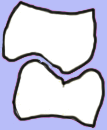Pestle
The pestle (called Mano in Central America) is a tool with which grated material is crushed in a thick-walled mortar or which is used to make ointments and creams in a fantasy dish . The work surface (the spherical end) of the pestle for use in a mortar is roughened, which increases the friction. In contrast, the pestle for producing semi-solid preparations in the pharmacy is smooth.
The pestle was used for grinding as early as the Stone Age. An archaeological find dating from around 3000 BC . BC is dated, the pestle of Cappel in Hesse .
Linguistically related is pesto (from Italian pestare "to crush"), a sauce that is originally made in a mortar.
Similar devices
Pestles are used to crush material in a vessel, so they do not need to be suitable for rubbing. Often, however, the crushed material should then be ground further with the same tool. That is why many pestles are also pestles and can then also be called that.
The term grater (more rarely: grater ) applies above all to larger tools of the same kind that are used in the kitchen.
The glass runner for grinding pigment paints works in a similar way to the pestle .
Mortar and pestle principle in dentistry
The food is chopped up because the cusps and dimples of the upper and lower teeth can work using the mortar and pestle principle.
Individual evidence
- ^ S. Ebel and HJ Roth (editors): Lexikon der Pharmazie , Georg Thieme Verlag, 1987, p. 518, ISBN 3-13-672201-9 .
- ↑ Entry on mortars. In: Römpp Online . Georg Thieme Verlag, accessed on December 25, 2014.
- ↑ Cf. Pistill at Duden online, indication of the meaning: "Stößel"
- ↑ See grater at Duden online


